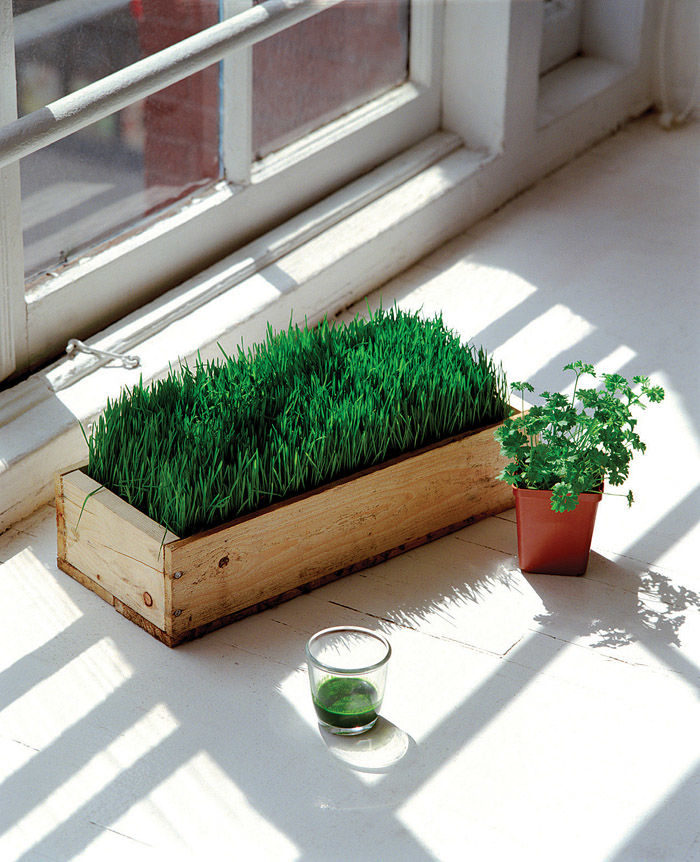Experiment with growing edibles indoors with window gardening
Published 7:00 am Wednesday, September 11, 2019

- A sunny location is necessary when cultivating an indoor herb garden.
There’s a good chance I’m repeating myself with today’s food topic — but if I am, it’s because I’m determined to learn how to grow herbs indoors. “They” say, when at first you don’t succeed, try again. Well, this is possibly the fourth time I’ve killed all the herbs I’m trying to grow indoors, so when I found this story, I knew I wanted to share the concepts.
The only thing surviving in my antique planter at present time is a 2-inch stalk of celery rooted from the discarded bottom of a purchased bunch. Since celery is a regular part of my morning smoothie diet, planting the bottom to see if it would root made a lot of sense. Rooting happened before but I didn’t get the new plant in soil quickly enough so it died before making a crop.
The thyme, rosemary, cat nip and basil planted in the same container near the patio window bit the bullet as well. The lifeless twigs remained far too long in the soil hoping for a resurrection, but it never happened. Now the lone celery is the only thing in the antique trough planter. The slightly larger matching mate once held beautiful herbs, but when that Rascal cat ate the fresh thyme like he was starving, the decision to leave the natural soil for his enjoyment seemed appropriate. One for growing, one for cat naps.
Today’s tips are from Metro Creative Services, a resource for any subject I need help writing about. The recipes are just some that sounded really good using herbs.
Tending an indoor herb garden
Fresh herbs and recently picked ingredients can add flavor to any meal. A home chef can even improve the flavor of store-bought or prepared foods with an herb garnish that can transform otherwise bland dishes into something family and guests will want to eat again and again.
Harvesting fresh herbs is easy for homeowners who have gardens right in their backyards. However, not everyone has a backyard, and even those who do might find their gardens threatened by changing seasons or unwanted critters. When gardens are moved indoors, the bounty of fresh ingredients continues no matter the date on the calendar.
Herb gardens are perhaps some of the easiest gardens to cultivate indoors because they don’t require large pots or much space. The plants themselves are relatively compact, and it only takes a pinch of herbs to give a meal some extra flavor.
When growing herbs indoors, the indoor growing area must have adequate light to simulate the longer days of summer; otherwise, the plants may go dormant. It’s ideal to have a southern exposure on the herbs, with at least eight hours of sunlight per day. (That’s my first problem.) If not living with a particularly sunny locale, consider supplementing the plants with grow lights, which will provide the full spectrum of light the plants needs to thrive.
Indoor air can become too dry for herbs, so compensate by providing humidity. While there may be added humidity in a kitchen greenhouse window, it still may not be enough to keep the plants healthy. Think about misting the plants daily to create some extra humidity, or place herb pots on top of a water-filled tray with pebbles so the evaporating water will add moisture without making the roots soggy.
Insects are another threat to indoor gardens because there is no cold weather to inhibit the hatching of insect eggs. Soil from outdoors may be more susceptible to insects that are already living in the dirt. Instead of soil from outside, use packaged soil or a non-soil alternative that will hold moisture without the added risk of bugs. If small insects appear, use a mist of soapy water to kill the bugs without harming the plants or making the herbs unfit for eating.
Group herbs together according to their watering needs to make maintenance that much easier. New sprouts generally need more water than established plants. Prune the herbs as needed for recipes. If the herbs experience a growth spurt, trim some of the plants and freeze the herbs for later use.
Many indoor herb gardeners begin by growing parsley, chives, oregano and basil, but experiment with just about any herb.
Suggested edible garden crops
Foodies find it hard to beat vine-ripened tomatoes plucked right out of a garden. Other edibles, such as fresh lettuce for a small luncheon salad or a handful of fresh parsley right out of a pot to add to a marinade, also add a lot to meals.
The convenience and flavor of freshly grown edibles propels many home gardeners to grow produce and herb gardens in their yards. But those short on outdoor space may be happy to learn that many edibles grow equally as well indoors as outdoors.
Many people maintain comfortable temperatures between 70 and 75 degrees in their homes all year long, which can be the ideal condition for growing an array of edibles no matter the season. For those with homes that receive ample sunlight, or if homeowners are willing to supplement with artificial light, growing conditions can be even stronger. An indoor garden can comprise as much space as a homeowner is willing to devote. Shelving can maximize vertical areas and enable gardeners to include even more planting room.
Keep these tips in mind when cultivating indoor edible gardens.
• TOMATOES: Tomatoes should be reserved for the sunniest spot in a home or one where additional UV light can be used. Tomatoes will need pots or containers that are roughly six inches deep with ample drainage. Keep in mind that tomatoes grown indoors will be smaller than outside fruits, and consider plum or cherry tomato varieties.
• CUCUMBERS: For those fresh salad mixes, cucumbers can be grown indoors in large pots so they can have space to develop. Be sure to put a climbing structure in the pot so that vines can grow vertically, and place cucumbers in a sunny, warm location.
• CARROTS: Natural Living Ideas says that if you have between four and five hours of bright sunlight per day and deep pots with loose, well-draining soil, you can cultivate carrots indoors. Carrots prefer cooler spots for sweet yields. Plus, carrot greens can make for attractive indoor decorations.
• MICROGREENS: Swiss chard, basil, dill, kale and other greens can provide nutrient-dense additions to any meals. These plants do not require a lot of depth to a container and can thrive on a sunny windowsill in a room that’s between 60 and 70 degrees.
• SCALLIONS: These plants of the onion family add flavor to many recipes. When scallions are grown at home, gardeners can snip off the greens as needed. Choose deep pots so the scallions can establish strong root systems.
• TURNIPS: Large, deep pots are needed to grow turnips, says Loyal Gardener. Grow them from seeds and be harvesting turnips in about two months.
Homeowners or apartment dwellers can experiment with different types of edibles indoors. The result can be fresh foods no matter the season — and that’s good eating.
Good food on the horizon
Speaking of good eating, this past Sunday a group of cooks who have participated in recent Cajun Creole Cookbook Cookoffs spent the afternoon reviewing The Daily Iberian cookbooks beginning in 1952. At that time the Louisiana Sugar Cane Festival souvenir program and cookbook were combined. The history, people and suggestions for cooking everything from basics to exotic foods — like the blackbird pie or pregnant potatoes, lets the reader know there were some creative cooks back in the day. Ann Patout was among the group and was passionately insisting every recipe in the 1969 cookbook is worth remembering. But only a handful in any one year will be featured in the 2019 commemorative edition expected out the week of the Louisiana Sugar Cane Festival.
SKIRT STEAK WITH CHIMICHURRI SAUCE
1 pound skirt steak (or flank steak), any large parts of fat trimmed beef
Salt and pepper
Chimichurri Sauce
1/2 cup parsley leaves torn from 1 bunch, some stems OK
1/2 cup cilantro leaves torn from 1 bunch, some stems OK
3/4 cup olive oil
1/4 cup red wine vinegar
3 cloves of garlic
1 teaspoon red pepper flakes
1/2 teaspoon salt
1/2 teaspoon pepper
CHIMICHURRI SAUCE — Combine all the ingredients in a food processor. Pulse for about 10 to 15 seconds until just combined but don’t over pulse and turn this into a smooth sauce. Transfer to a container and set aside.
STEAK — Preheat grill (or indoor grill pan) over high heat, and brush with olive oil. Season generously with salt and pepper. Grill on each side about 5 to 6 minutes, or until it reaches an internal temperature of 135 degrees for medium rare. Transfer to a cutting board and allow to rest for 5 minutes. After the steak has rested, slice it against the grain into 1/2-inch thick slices. Serve topped with chimichurri sauce.
Natalie at Tasteslovely.com
CITRUS BLUEBERRY THYME CAKE
Step 1) BLUEBERRY FILLING
3/4 cup (5-1/4 ounces) granulated sugar
2 Tablespoons low sugar pectin (Sure-Jell for low-sugar recipes/pink box)
1/8 teaspoon fine sea salt
2 cups (9-ounces) fresh blueberries
1 teaspoon grated lemon zest
1 Tablespoon lemon juice, freshly squeezed
Whisk sugar, sure-jell and salt together in small saucepan. Process blueberries in blender until mostly smooth, about 1 minute. Transfer 1/4 cup pureé and zest to saucepan with sugar mixture and stir to thoroughly combine. Bring mixture to simmer over medium heat, about 3 minutes, stirring frequently to dissolve pectin and sugar. Transfer mixture to medium bowl, add remaining pureé and lemon juice to cooled mixture and whisk to combine. Let sit until slightly set, 8 to 10 minutes.
Step 2) BUNDT CAKE
3 cups all-purpose flour
2 1/2 Tablespoons fresh thyme, finely chopped
1 1/2 teaspoons baking powder
3/4 teaspoon baking soda
1 teaspoon fine sea salt
1/2 teaspoon ground cinnamon
1/2 teaspoon ground cardamom
3/4 cup buttermilk
2 Tablespoons lemon juice, freshly squeezed
1 Tablespoon lime juice, freshly squeezed
2 teaspoons vanilla extract
2 Tablespoons grated lemon zest
1 Tablespoon grated lime zest
2 cups granulated sugar
18 Tablespoons (2 1/4 sticks) unsalted butter, softened
3 large eggs plus 1 large yolk, room temperature
Blueberry Filling, recipe above
Pre-heat oven to 325 degrees. Grease and flour Bundt pan. Whisk flour, thyme, baking powder, baking soda, salt, cinnamon and cardamom together in large bowl. In a separate bowl, whisk buttermilk, lemon juice, lime juice and vanilla together, set aside. In a stand mixer, mix zest and sugar with fingers tips until it resembles wet sand. Add butter and beat on medium-high until pale and fluffy, about 3 minutes, scraping down bowl as needed. Reduce speed to medium, add eggs and yolk, one at a time, until incorporated. Reduce speed to low; add flour mixture alternating with buttermilk mixture beginning and ending with dry ingredients. Beating each addition until barely combined. After final flour addition, beat on low until just combined. Remove bowl from mixer and finish folding batter with rubber spatula to fully combine. Let batter sit for 15 to 20 minutes. Spoon half of batter into prepared pan and smooth top. Using back of spoon, create 1/2-inch-deep channel in center of batter. Spoon half of filling into channel. Using small offset spatula, gently swirl filling into batter using figure-8 motion, being careful not to drag filling to bottom or edges of pan. Repeat steps with remaining batter and filling. Bake until top is golden brown and wooden skewer or toothpick inserted into center comes clean, about 45 to 55 minutes. Cool cake in pan on wire rack set over baking sheet for 10 minutes, then invert cake directly onto rack.
Step 3) CITRUS GLAZE & ASSEMBLY
2 Tablespoons lemon juice, plus more if needed to thin out glaze
2 tablespoons lime juice
2 cups confectioners’ sugar
1/2 cup fresh blueberries for decoration (optional)
Lemon and Lime zest for decoration (optional)
While cake is baking, whisk together juices and sugar until smooth, adding more lemon juice gradually as needed until glaze is thick but still pourable. After inverting cake, pour half of glaze over warm cake and let cool for 1 hour; pour remaining glaze evenly over top of cake and continue to cool to room temperature, about 2 hours. Decorate cake with blueberries and citrus zest, if desired.
Ken at HungryRabbit.com





